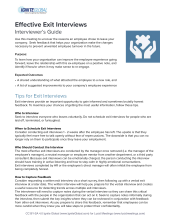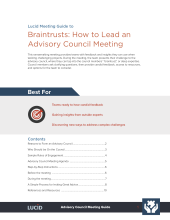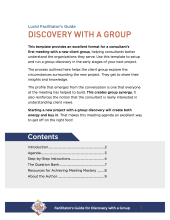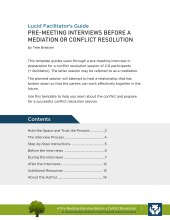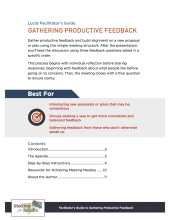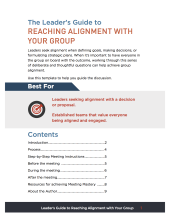You can find an introduction to Sensemaking Meetings in Chapter 29 of Where the Action Is. These resources will help you plan, run, and troubleshoot the specific Sensemaking Meetings your team needs.
Definition
A Sensemaking Meeting is used to find answers to questions and improve shared group understanding of a topic or situation.
Questions Answered
- What can we learn from each other about this topic?
- How can we make sense of this situation?
Examples
- Project Discovery Meetings
- Incident Investigations
- Doctor/Patient Consults
- Community Input Sessions
- Market Research Panels
- Situational Analyses
- Informational Interviews
Purpose
- To learn things you can use to inform later action.
- To gain an understanding of the current state of a project, organiza-tion, or system.
- To get help figuring something out.
Work Outcomes
- Shared information.
- New data or insights that can translate into action.
Human Outcomes
- Support and a sense of being “in it together.”
- A better understanding of the current situation.
- Insight
Meeting Agenda Templates and Guides
How to Conduct Effective Exit InterviewsKim Seeling Smith - Use this meeting to uncover the reasons an employee chose to leave your company. Seek feedback that helps your organization make the changes necessary to prevent unwanted employee turnover in the future. |
|
How to Lead an Advisory Council (Braintrust) MeetingElise Keith - This sensemaking meeting provides teams with feedback and insights they can use when tackling challenging projects. During the meeting, the team presents their challenge to the advisory council, where they can tap into the council members’ “braintrust,” or deep expertise. Council members ask clarifying questions,... [ more ] |
|
How to Run a Discovery MeetingIngrid Bens - This meeting agenda template provides an excellent format for a consultant’s first meeting with a new client group, helping consultants better understand the organizations they serve. The process outlined here helps the client group explore the circumstances surrounding the new project. They get to share their... [ more ] |
|
How to Run a Mediation Preparation MeetingKavana Tree Bressen - This template guides users through a pre-meeting interview in preparation for a conflict resolution session of 2-6 participants (+ facilitator). The latter session may be referred to as a mediation. The planned session will attempt to heal a relationship that has broken down so that the parties can work effectively... [ more ] |
|
How to Run a Proposal Feedback MeetingRichard Lent, Ph.D. - Gather productive feedback and build alignment on a new proposal or plan using this simple meeting structure. After presenting the proposal, you’ll lead the discussion using three feedback questions asked in a specific order. This meeting agenda template can be used to create a stand-alone meeting dedicated to... [ more ] |
|
How to Run a Team Alignment MeetingPaul Axtell - Leaders seek alignment when defining goals, making decisions, or formulating strategic plans. When it’s important to have everyone in the group on board with the outcome, working through this series of deliberate and thoughtful questions can help achieve group alignment. This meeting agenda template provides a... [ more ] |
|
How to Run COVID-19 Team Meetings Using ORIDBarbara MacKay - This guidebook explains how to prepare for and run important conversations regarding COVID-19 with your team using the ToP® Focused Conversation Method. Barbara MacKay briefly introduces the ToP® Focused Conversation Method, which was developed by the Institute of Cultural Affairs. This simple, logical approach to... [ more ] |
Recommended Reading & Resources
Blog Posts
- "Is this really an "ancient Chinese proverb"?". Metafilter (2013).
Books
- The Facilitator’s Guide to Participatory Decision Making. Sam Kaner (2014).
- The Knowledge Illusion: Why We Never Think Alone. Steven Sloman, Philip Ferbach (2017).
Research Papers
- SENSEMAKING Framing and Acting in the Unknown Deborah Ancona, MIT-Sloan School of Management
Glossary of Meeting Terms
Technique
The 2x2 Matrix is a decision support technique where the team plots options on a two-by-two matrix. Known also as a four blocker or magic quadrant, the matrix diagram is a simple square divided into four equal...
The 5 Whys is a technique used to determine the root cause of an issue. By repeatedly asking the question “Why” (five is a good rule of thumb), you can discover symptoms which may lead to the reason a problem exists...
An affinity diagram organizes a large number of ideas into related sets. Groups often create an affinity diagram as the second step in a brainstorming session. After everyone adds their ideas, the team looks at the...
Appreciative Inquiry techniques seek to build on the positive outcomes, successes, and highlights in a situation instead of focusing on how to counteract negative forces. Practitioners recognize that people are...
Argument Mapping is a technique for graphically breaking down and showing the reasoning (or argument) behind a statement. In a meeting, groups can use Argument Mapping to explore the underlying assumptions behind a...
Causal Layered Analysis (abbreviated as CLA) is a group sense-making technique used to explore the underlying causes and worldviews contributing to a situation. Working together, groups made up of people representing...
Challenging Assumptions is a sense-making technique designed to break apart a statement and discover where assumptions may be limiting your options. There are several ways of leading a group through an exercise...
Concept mapping is a technique for graphically organizing and representing knowledge. The maps include concepts, usually enclosed in circles or boxes, and relationships between the concepts indicated by a connecting...
Creative Problem Solving (CPS) is a method that attempts to approach a problem or a challenge in an innovative way. The process helps redefine problems and opportunities to come up with new responses and solutions....
DeBono's Six Thinking Hats is a dialogue technique for looking at a decision from multiple angles. Individual group members take on an assigned perspective (or "Thinking Hat") for the duration of the discussion. For...
A decision tree is a decision-making aid that compares options by projecting what the expected outcome of each choice might be. Teams that use a decision tree often draft the tree together in a meeting on a...
Decision making technique designed to combat groupthink. One or more people in the group takes the "devil's advocate" role, and works to point out all the flaws and risks with an option under consideration.
Dialetical inquiry is a group decision-making technique that attempts to combat group think. The practice reportedly originated with Plato, who asked his students to consider both the thesis and antithesis to any...
Environment scanning is a sense-making exercise teams use to uncover the outside trends that they should consider during the strategic planning process. Teams research and brainstorm the trends they see in their...
A fishbone diagram is a visual technique that teams use to organize their thinking and identify causes for a problem. The diagram starts with a process or problem written at the right center of the board, with a long...
Teams conduct a force field analysis when they need to make go/no-go decisions. Teams start by writing the proposed change down the center of the diagram. To the left, they list the forces driving change, with an...
The gallery method is a way of generating and building on ideas in a group. To begin, the group reviews a problem statement or challenge. Then, everyone takes 30 minutes or so to sketch 2 or 3 solution ideas. These...
An Influence Diagram is a compact, graphical way to look at the factors involved in making a decision. Influence diagrams show how the decisions, variables at work, and desired outcomes relate to one another, which...
The KJ-Method or KJ Technique, is an idea generating and prioritizing technique named after its inventor, Jiro Kawakita. This technique is one of the most popular brainstorming variations for design, team,...
The Lotus Blossom Technique is a structured brainstorming exercise used to expand on a central idea or problem. Teams place the original problem statement in the center box in a 3x3 matrix, then add related themes or...
Mind Mapping is a visual way to represent a central idea and related themes. The central idea is written in the center, and related ideas are placed surrounding the central idea with lines connecting them, like...
ORID is an acronym describing the 4 stages of questions that facilitators can use to focus a conversation towards a useful result. ORID stands for:
Objective: questions about facts, about what is.
Reflective:...
PALPaR is a technique used by presenters to create an effective exchange in response to a proposal. The name of the technique is an acronym for:
Present
Ask
Listen
Pause
and
Reply
To...
A Pareto Analysis is a decision-making technique used to choose a limited number of actions to take that will result in a significant impact. The analysis uses the Pareto Principle (the 80/20 rule), which states for...
A PEST analysis is a sense-making technique used in strategic planning and situational analysis. Participants brainstorm and map out what's changing in their operating environment, then brainstorm the opportunities...
PMI is a brainstorming technique for gathering feedback on an idea, concept, or when a team takes a retrospective look at a recently completed set of work. After introducing the idea, the group is asked to write...
Teams use the Polarity Map® technique in meetings to explore the benefits and problems with opposing factors, or poles, that play against each other when making a decision, especially when both alternatives have...
Progressive questioning is a technique for fully exploring a topic by asking a series of related questions. There are several progressive questioning techniques designed to fit different situations.
Using 5 Whys...
Ritual dissent is a workshop technique designed to overcome taboos against publicly critiquing ideas. The goal is for the presenter to hear candid, useful feedback.
During a workshop, a presenter shares their idea...
SCAMPER is a creative thinking and problem-solving technique that guides groups to evaluate an idea by exploring similar or related ideas. SCAMPER stands for:
Substitute: looking at what can be switched out in...
Six Serving Men is a team exercise that examines an issue from twelve different viewpoints. It is based on the words of the poem by Rudyard Kipling:
I keep six honest serving men, they taught me all I knew.
Their...
The SOAR analysis technique is used by teams as part of the planning process. SOAR stands for Strengths, Opportunities, Aspirations, and Results. SOAR was developed by Appreciative Inquiry practitioners looking for...
The Strategic War Room, contributed by Krister Forsberg, provides a way for leadership teams to come to a common understanding of insights about the organization. When complete, leaders get a comprehensive view (both...
A SWOT Analysis is an analysis of a group's Strengths, Weaknesses, Opportunities, and Threats. A SWOT analysis may be conducted as part of an Environmental Scan in preparation for strategic planning. Strengths and...
An analogy is a comparison that points out the similarity between the like features of two different things. The Analogies and Metaphors technique in meetings helps participants clarify their understanding of an...
Teams may create a timeline of events together in a meeting as a sense-making exercise that helps everyone understand both what happened to lead to the current situation, learn aspects of the situation that may have...
There are multiple meeting and thinking techniques called TRIZ.
Liberating Structures describes TRIZ as meeting exercise designed to help groups identify counterproductive things they may be doing and find ways to...
Meeting Type
A discovery meeting is a form of investigative meeting used by consultants, designers, and project teams to learn more about a project's requirements. During a discovery meeting, one or more people interview the...
A walking meeting is exactly what it sounds like; a meeting conducted while walking. Proponents of walking meetings say walking meetings lead to more natural conversations and enhanced creativity. They cite research...
